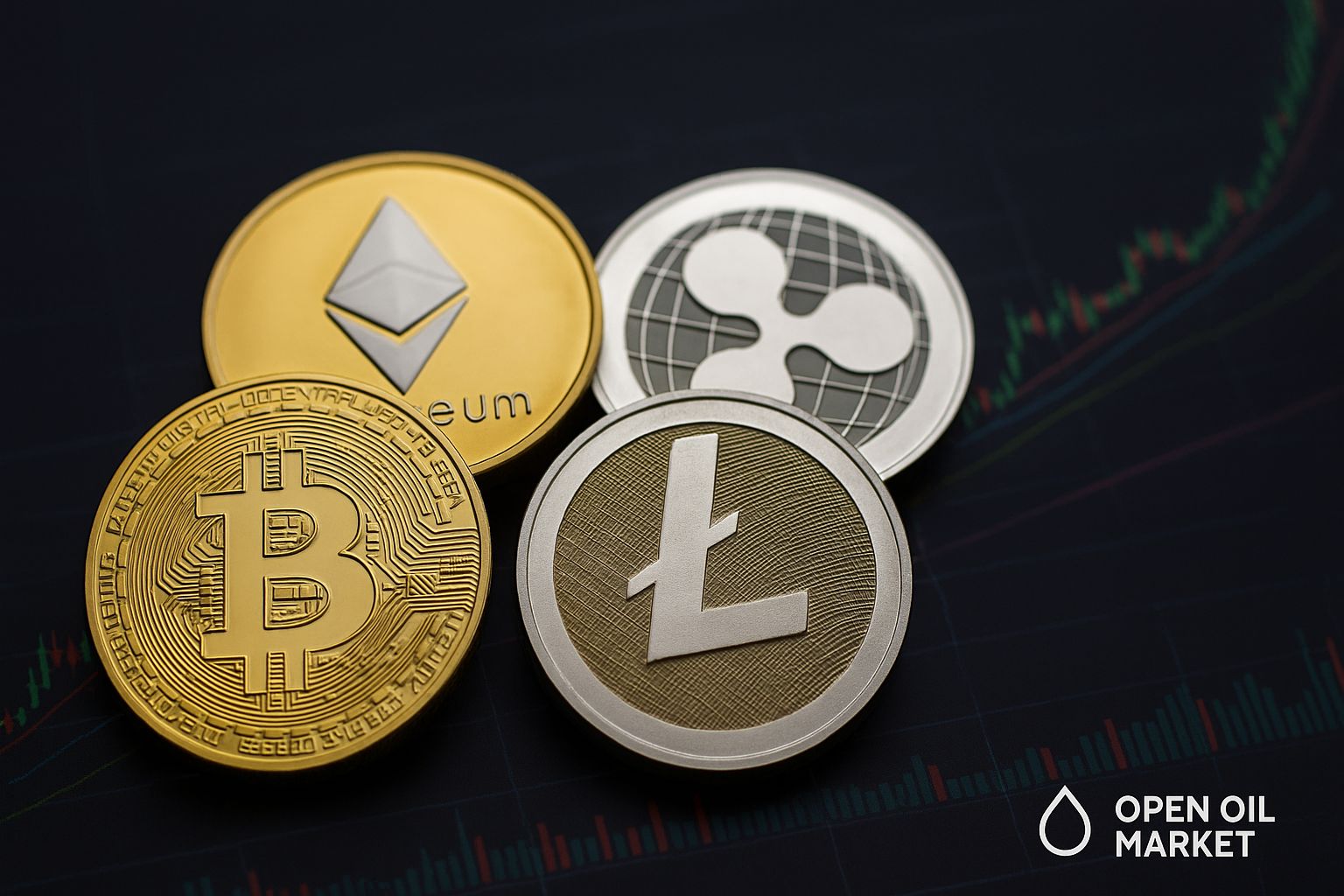
Current Cryptocurrency News as of October 26, 2025: Bitcoin Price, Ethereum Growth, Market Movements, and Investor Predictions.
As of the morning of October 26, 2025, the cryptocurrency market is exhibiting relative stability following recent price fluctuations. Over the past few days, major digital assets have recuperated some losses incurred earlier in the month. The flagship Bitcoin remains above the psychologically significant mark of $110,000, supporting the total market capitalization in the range of $3.5–3.6 trillion. Ethereum is following Bitcoin, trading around $4,000, indicating a return of upward momentum despite ongoing volatility.
Investors are gradually returning to a cautious optimism as October draws to a close, while closely monitoring external factors and upcoming events—from regulatory decisions on crypto funds to macroeconomic signals—striving to maintain a balance between greed and fear.
- Market Capitalization: ≈ $3.6 trillion
- Bitcoin's Share: ~53%
- Fear and Greed Index: 45 (fear)
Market Overview: Stabilization by Month-End
The current month has proven to be extremely volatile for the cryptocurrency market. After reaching a new all-time high for Bitcoin above $125,000 at the beginning of October, the market experienced a sharp decline due to a sudden escalation in trade relations between the U.S. and China. Reports of conflict escalation triggered a rapid sell-off, resulting in record liquidation volumes. Consequently, the total value of digital assets temporarily decreased, causing sentiment indices to plunge into the "extreme fear" zone. However, by the month’s end, the situation stabilized: major cryptocurrencies returned to growth, and investor sentiment improved amidst easing macroeconomic uncertainty and encouraging inflation data.
Bitcoin Maintains Strong Position
The flagship Bitcoin (BTC) has demonstrated resilience following the recent wave of selling. Currently, its price is hovering around $110,000, only slightly below the record peaks from earlier in the month (~$126,000). The key support level around $105,000 has withstood the October downturn, reinforcing market participant confidence. BTC's dominance in market capitalization is rising again, approaching 50% of the entire crypto market, as funds shift from more risky altcoins into this primary digital asset. Experts note that long-term factors—from the halving event to the launch of Bitcoin-based ETFs—continue to foster a bullish sentiment around BTC, despite short-term price fluctuations.
Ethereum Strengthens Above $4,000
The second-largest cryptocurrency by market capitalization, Ethereum (ETH), is confidently recovering after a recent downturn. The price of ETH has returned to levels around $4,000, recovering from a mid-month drop (amid panic, prices dipped to approximately $3,400). Ethereum remains a key platform for decentralized finance (DeFi) and non-fungible tokens (NFTs), continuing to attract developers and capital. Recently, the first Ethereum-based ETFs were launched, and the development of layer-2 networks (such as StarkNet and zkSync) enhances the appeal of this ecosystem for institutional investors. Analysts believe that if current trends persist, Ethereum could near historical highs, particularly as overall market sentiment improves.
Ripple and XRP: Institutional Successes and Expectations
The XRP token issued by fintech company Ripple has emerged as one of the leaders in growth due to increasing institutional interest. Its price recently exceeded $2.50, reaching a multi-year high. The upward trend of XRP is supported by a series of positive developments. Firstly, in the summer of 2025, Ripple achieved a significant victory in its protracted legal battle with the SEC in the U.S., removing significant uncertainty surrounding XRP's status. Secondly, the company is expanding its offerings for institutional clients: the Ripple Prime platform has been launched for institutional services, and Bitcoin-related ETFs have appeared in certain countries, linking XRP. These steps bolster investor confidence and support demand for the token, which re-enters the list of the most valuable cryptocurrencies by market capitalization.
Furthermore, the market is cautiously optimistic about the U.S. regulator's decision on the first spot ETF for XRP. Approval of such a fund would represent a historic move, opening access to XRP for a broader group of investors and likely providing additional momentum for price growth. Conversely, a rejection or further delay could trigger a short-term decline; however, long-term holders—after achieving legal clarity—remain confident in XRP's prospects.
Solana and Other Altcoins: Selective Growth
The altcoin segment shows mixed dynamics as October comes to a close. Solana (SOL) stands out with its price rising to approximately $200, showing about a 5% increase over the week. Solana is attracting attention from institutional players and is increasingly viewed as an indicator of market risk appetite—especially after its trading volume on decentralized platforms surpassed that of Ethereum. Meanwhile, other major altcoins are showing divergent trends. For instance, the Binance exchange token (BNB) has strengthened considerably amid positive news surrounding the Binance ecosystem, while Tron (TRX) has pulled back after a previous rally. Cardano (ADA) holds around $0.65, and the meme-based cryptocurrency Dogecoin (DOGE), after a recent drop, has managed to return to levels around $0.20, marked by a spike in trading activity. Overall, interest in alternative coins remains selective: investors prefer projects with clear growth drivers while avoiding excessively speculative assets.
Institutional Investment and Regulation
The influx of institutional capital into cryptocurrencies reached record levels in 2025, significantly aided by regulatory shifts. In the U.S., the first ETFs linked to spot Bitcoin have been launched, providing traditional investors with a convenient tool for investing in crypto assets through the stock market. Similar products are emerging abroad—from Ethereum ETFs to investment funds focusing on individual altcoins—indicating global recognition of digital currencies. The European Union is implementing the comprehensive MiCA regulation, establishing unified rules for the crypto market across EU territory and attracting new financial institutions into the industry. In several jurisdictions (e.g., UAE and Hong Kong), crypto-friendly licensing regimes are being introduced, drawing innovative blockchain companies and capital into the sector.
Positive changes have also influenced the largest market participants. For instance, regulatory risks for the leading exchange Binance have decreased significantly: its founder received pardons from U.S. authorities on a number of charges, alleviating longstanding pressure on the company. Together, these factors bolster confidence in the industry, lowering barriers for a new influx of institutional money into the crypto market.
Top 10 Most Popular Cryptocurrencies
- Bitcoin (BTC) – the first and largest cryptocurrency, the "digital gold" of the market; its market capitalization is approximately $2 trillion.
- Ethereum (ETH) – the leading platform for smart contracts and decentralized applications, the foundation of DeFi and NFT ecosystems.
- Tether (USDT) – the primary stablecoin pegged to the U.S. dollar; widely used for trading and hedging risks.
- Binance Coin (BNB) – the token of the largest crypto exchange Binance, used for paying fees and services; its position has strengthened thanks to the growth of the Binance ecosystem.
- Ripple (XRP) – a token for cross-border payments issued by Ripple; experiencing a rise due to regulatory successes and partnerships with banks.
- Solana (SOL) – a high-speed blockchain for smart contracts, competing with Ethereum for DeFi projects; characterized by high throughput and growing popularity.
- USD Coin (USDC) – the second most significant stable digital dollar, issued by the Circle consortium; trusted by institutional players.
- Tron (TRX) – a blockchain platform for smart contracts and decentralized services, known for high transaction activity and stablecoin issuance on its base.
- Dogecoin (DOGE) – a "meme" cryptocurrency that has become a popular speculative asset; sustained by an active community and support from well-known market enthusiasts.
- Cardano (ADA) – a blockchain platform developed through a research-driven approach and phased updates; attracts long-term investors with its technological solutions.
Conclusion and Outlook
Overall, the cryptocurrency market in the autumn of 2025 demonstrates a combination of resilience and caution. The rapid rebound following the recent major sell-off confirms the fundamental strength of the industry: key assets have maintained their positions, and long-term investors have taken advantage of lower prices to replenish their portfolios. At the same time, ongoing macroeconomic risks and recent volatility temper excessive enthusiasm—sentiment indicators remain in a neutral-cautious zone. The coming months will test the market: if institutional money continues to flow in and regulatory clarity improves, cryptocurrencies have a chance to finish the year on a high note.
Many experts are confident that the "cleansing" of the market from excessive leverage, which occurred in October, has created a more robust foundation for further growth of digital assets. Major financial institutions are already raising their forecasts: for instance, Standard Chartered recently announced a target of $200,000 for BTC by the end of 2025. Several analysts predict that, if favorable conditions persist, Bitcoin could reach around $135,000 as soon as December, with an optimistic scenario potentially pushing it to $180,000. Thus, despite possible short-term fluctuations, the market is entering the final phase of the year with strengthened fundamental positions and cautious hope for continued growth.




